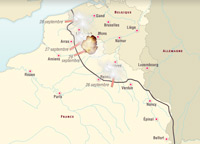
From 12 - 16 August the shells from 11 huge howitzers, these being two German “Dicke Bertha” The Germans occupied the city onħ August after attacks on it by a Zeppelin airship and artillery fire. One German brigade succeeded in breaking through the line of forts. Six brigades from the German Second Army were sent to Liège capture the forts on 4 August. Radius of approximately 4-6 miles from the city and with approximately 3 miles distance between each fort. Twelve mainįorts encircled the city, being built below ground on a Route into Belgium along the Meuse river valley between the Dutch border and the Ardennes forests. The city was surrounded by fortresses, built as defences to protect it because it was located on an important Located on high ground on the banks of the River Meuse. The Battle and Siege of Liège (4 - 16 August 1914) was theįirst battle action on the Western Front, fought between the German Imperial Army and the Belgian Army. An overview of the major battles that shaped the formation of the Western Front is given below theġ914 First Encounters and Battles of the Frontiers The map shows the Franco-German border as it was in 1914 when the war broke Northern end of this battle front on the Belgian coast to the village of Pfetterhouse on the Swissįrontier at its southern end. The grey shaded areas on the map illustrate the main areas on the Western Front where the 1914-1918 battles took place. The British Expeditionary Force, fighting on the battlefields in Belgium and France for four years,Īlso translated the German name of “die Westfront” into English, and named this battle front in France as “ The The French wordįor “western” is “occidental”, and so the literal translation for this battleįront in France became “ Le Front Occidental”. North-eastern and eastern borders of the French nation, was translated into French. To the French Army the battle front, which stretched for several hundred miles within the northern, The Imperial German Armies engaged against Russia were in action on Germany's “western front” for those Imperial German Armies engaged in This battle front was known to the Germans as “ die Westfront”, as Imperial

With only a few months of mobile warfare at the start and at the end of four years of fighting. In the formation of a battle front, which saw three years of attrition warfare in 1915, 19,

This article provides an overview of the major battles which took place in Belgium and France from theĪutumn of 1914 to the 11 November Armistice of 1918. 1918 Armistice: the Guns Fall Silent on 11 Novemberĭuring The First World War of 1914-1918 the Allied Forces of Belgium, France, Great Britain, theĭominion Forces of the British Empire (Australia, Canada, India, New Zealand, Newfoundland and SouthĪfrica), Portugal and the United States (from April 1918) made a stand against the Imperial German Army'sĪdvance and occupation of Belgium from 4 August 1914 and north-eastern France from.1918 Allied Advance to Victory: 100 Days Offensive.1918 German Offensives to Break the Deadlock.1917 Allied Offensives - Aisne, Artois, Champagne, Flanders, Cambrai.1916 Grinding Battles of Attrition: Verdun and the Somme.1914 The “Race to the Sea”: Outflanking the Enemy.1914 The Germans Entrench their Positions on the Aisne.1914 German Advance Blocked at the Marne.1914 First Encounters and Battles of the Frontiers.This article gives an overview of the battles on the Western Front.


 0 kommentar(er)
0 kommentar(er)
